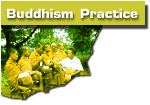 |
BANGKOK
|
||||||||
CENTRAL
|
||||||||||||
NORTHEASTERN
|
||||||||||||||
NORTHERN
|
||||||||||||
SOUTHERN
|
||||
 |
| A GUIDE TO MEDITATION CENTRES IN THAILAND |
| CENTRAL - WIWEK ASOM VIPASSANA MEDITATION CENTRE |
MEANING
OF NAME : |
"Quiet dwelling place" |
ALSO
SPELLED : |
Vivek Asrom Vipassana Meditation Center |
ADDRESS
: |
Tambon Ban Suan, Ampher Muang, Chonburi 20000 |
TELEPHONE
: |
0-3828-3766 |
DIRECTIONS
: |
Located just outside Chonburi on the road to Ban Bung.Buses leave frequently from Bangkok's Eastern (Ekamai) Bus Terminal for the one-hour trip. Get off at Ban Bung intersection in Chonburi, then walk or take a samlor to the meditation centre. |
MEDITATION
SYSTEM : |
Vipassana using techniques similar to those taught byMahasi Sayadaw. Based on Four Foundations ofMindfulness described in the Maha Satipatthana Sutta. Concentrationis developed on the rise and fall of the abdomen, then awareness is directed to physical and mental sensations. |
TEACHING
METHOD : |
Daily interviews with the teacher. |
TEACHERS
: |
Phra
Ajahn Asabha (Dhamma Chariya) (Burmese; age 79) Phra Ajahn Charlee Jaruvanno (Thai; age 54) Phra Ajahn Pramuan (Thai; age 60) |
LANGUAGE
: |
Phra Ajahn Asabha speaks only Thai and Burmese, but a translator can be arranged. The other teaching monks speak some English. |
DESCRIPTION
: |
Shaded, fairly quiet location on the edge of Chonburi.Simple, modern architecture. Kutis are fairly close together. Separate living and practice areas for men and women. |
SIZE
: |
monks
30-60 novices 3-7 nuns 20-30 laypeople 20-30 |
DAILY
ROUTINE : |
Meditators practice in meditation halls or in rooms according to their own schedule. Continuity of practice is stressed. Everyone is encouraged to meditate 20 hours a day. One should avoid socializing, reading, and leaving the centre during one's stay. |
FOOD
: |
Very good quality and variety. Monks and novices go on pindabat, then eat mindfully in their kutis. Laypeople can eat in the kitchen or take food to their rooms. A simple breakfast is served early morning, then the main meal in late morning. Laypeople can arrange for food, including vegetarian, to be ordered from shops and delivered to the centre. |
ACCOMMODATIONS
: |
Individual rooms or kutis with screens, electricity, and Thai-style bathrooms with running water. |
WRITE
IN ADVANCE? : |
Individual rooms or kutis with screens, electricity, and Thai-style bathrooms with running water. |
OTHER
INFORMATION : |
One should come with the intention of staying at least 2 weeks. Meditators follow the 8 precepts but may, if needed for health reasons, take food after mid-day. Phra Ajahn Asabha came to Thailand in 1953, after the Thai government extended an invitation to the Burmese government to send vipassana teachers. |
| Select here : |
|
|